 Common snakes which can often be found in Thailand. This list should make the layman’s search for these snakes easier and presents a specific summary of the parts of a snake.
Common snakes which can often be found in Thailand. This list should make the layman’s search for these snakes easier and presents a specific summary of the parts of a snake.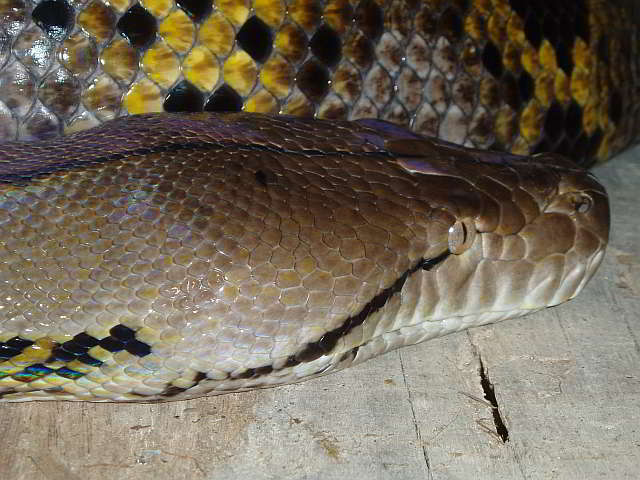
Picture: J. Bulian
 Malayoython (Python) reticulatus (Reticulatus Python)
Malayoython (Python) reticulatus (Reticulatus Python)Thai:
 (ngu lüam)
(ngu lüam)Length: One of the largest specimens ever was pictured in the January edition of the magazine "The Animal". The snake was captured in Thailand and, according to the magazine, has a body length of 12, 2 meters and a body weight of 220 kg. This snake has been sold to a snake reserve in Japan. The statement about the length and weight is sure to be inaccurate and probably heavily exaggerated. However it is proved that this snake can grow very long with this illustration of a Python on Siam-Info. The animal is now 7 years old (October 2007) and has already reached a length of 6,5 meters.
Distribution: The ReticulatedPython is to be found throughout Thailand. The animals can even be regularly found in the inner city areas of Bangkok.
Behaviour/habitat:
The ReticulatedPython was originally an inhabitant of the flat land woods. It prefers to be near water and is active at twilight and a night. The reticulated Python is a fantastic swimmer and is regular swimming long distances in the sea. Thesespecies were the first reptiles to resettle in the area after the outbreak of the volcano Krakatau on the islands of (Sumatra or) Java in 1888.
Danger level: These snakes are very aggressive and bite at the slightest disturbance. A snake from 4 meters long and upwards poses a danger to humans, not because of its venomous, but because of its sheer size.
*2 RAWLINGS et al. transfered Python reticulatuns in the new genus Broghammerus. If this change will be generally accepted remains to be seen.
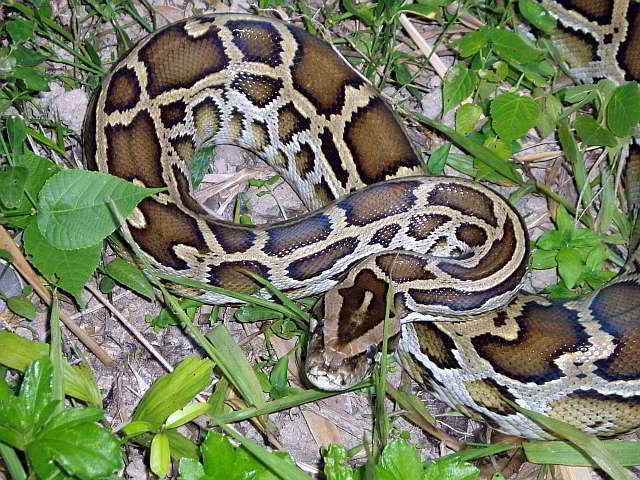
Picture: J. Bulian
 Python bivittatus bivittatus (Burmese Python)
Python bivittatus bivittatus (Burmese Python)Thai:
 (ngu larm)
(ngu larm)Length: up to 7m
Most specimen do remain smaller. The longest example was owned by the owner of a private zoo in Bangkok, Mr. Siah and reached a total length of 8,8 m.
Distribution: from North Thailand to the Isthmus of Kra
Behaviour/habitat: The dark Tiger Python is an inhabitant of the grassy countryside with trees and lightly wooded areas. They are often found at the edge of hills and mountains. Specimens have also been found in the inner city areas of Bangkok, although less often than the Python reticulatus. These snakes are active at night and at twilight. They eat warm-blooded mammals up to the size of a German shepherd. Just like all pythons, the Dark Tiger Python also lays eggs which it incubates. The temperature of 31 degrees required for incubation is achieved by contracting the muscles. A total of up to 100 eggs can be laid. The largest amount of eggs ever laid was 107 eggs which were approx. 12X6 cm. The young snakes hatch out of their shells after around 58 days.
Danger level: The Burmese Python is more of a peaceful snake and does not tend to bite. A potential danger is present due to its size.
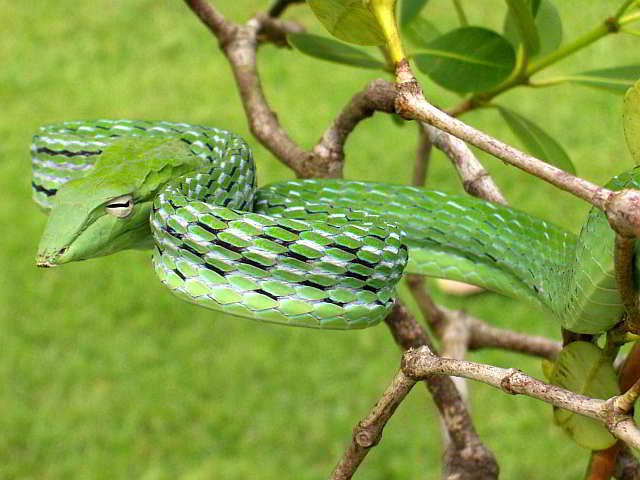
Picture: J. Bulian
 Ahaetulla prasina (Oriental Whip snakes)
Ahaetulla prasina (Oriental Whip snakes)Thai:
 (ngu kieo hua ching chok pa)
(ngu kieo hua ching chok pa)Length: Up to 190 cm
Distribution: This subspecies is found throughout Thailand.
Habitat/behaviour: By day these snakes inhabit the trees and shrubs of agricultural lands and forests. They lie in loose loops on the branches. By night, the snakes sleep in the same position in shrubs and trees, where they stay mostly on the outer branches. They feed on frogs, lizards, and birds. Rodents are generally not eaten by these snakes. In Thailand the ahaetulla prasina has 2 mating seasons per year. The main mating activities take place between the end of April and the beginning of July. However, mating can also take place between December and January.
Gestation lasts approximately 6 months. The females give birth to between 4 and 10 young animals, which are between 420 and 510 mm long at birth.
Danger level: Although this is considered to be a rearfanged snake it is not dangerous to humans. The venomous must be massaged into the bite wound by a chewing motion in order to be effective. Even with small lizards it takes the venomous some 15 minutes to have an effect. When excited the snakes expand their neck area in order to appear larger. In this position it is possible then to see the banded region of the intermediate skin. In addition, the snake extends its tongue and holds it some seconds in this position. Besides the completely green snakes, they also appear as yellow or brownish, especially when juvenile.
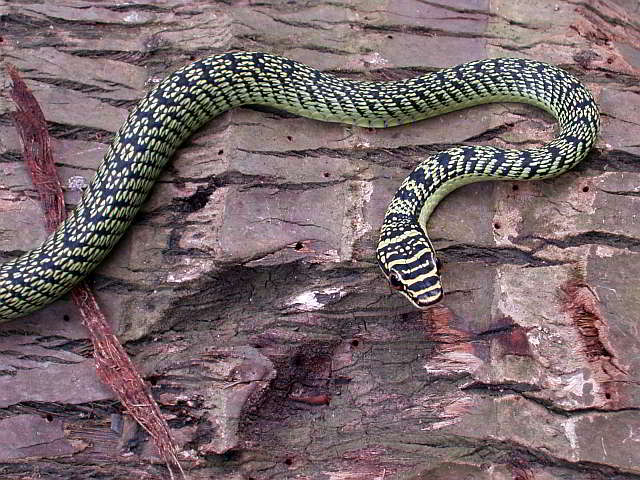
Picture: J. Bulian
 Chrysopelea ornata ornatissima (Golden Tree Snake)
Chrysopelea ornata ornatissima (Golden Tree Snake)Thai:
 (ngu kieo lai dok mak)
(ngu kieo lai dok mak)Length: Up to 140 cm
Distribution: The Golden Tree Snake is to be found throughout Thailand.
Behaviour/habitat: Chrysopelea Ornata Ornattissima is a flexible snake. It can be found in forests, on plantations, in gardens and in houses. This snake is regularly found in the inner city areas of Bangkok and Pattaya. As they enjoy eating rodents, geckos and other lizards, they are often found on and in houses. These snakes are active during the day, can climb walls and are very fast.
Danger level: If they feel threatened and cannot flee, they bite straight away. The species Chrysopelea belongs to the family of rearfanged snakes. However, the venomous is so mild that it does not have much of an effect on humans.
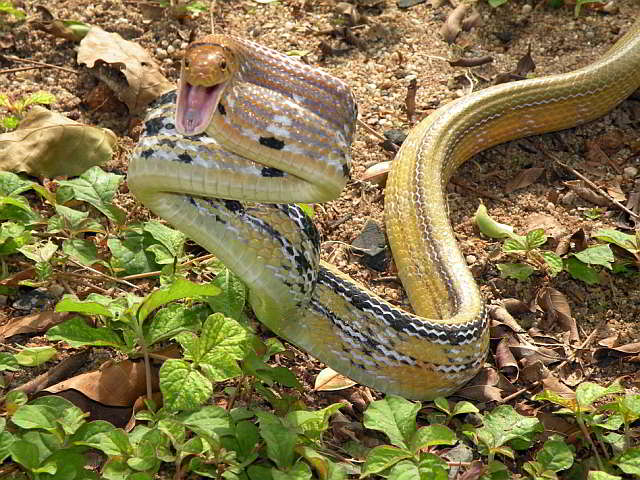
Picture: J. Bulian
 Coelognatus radiatus (Copperheaded Racer)
Coelognatus radiatus (Copperheaded Racer)Thai:
 (ngu tang maprao lai keet)
(ngu tang maprao lai keet)Length: Up to 230 cm
These snakes generally reach a length between 150 and 180 cm.
Distribution: The Copperhead Rat Snake is found throughout Thailand.
Behaviour/habitat: Coelognathus radiatus resides in all types of habitats up to a height of 1500 meters. You will find this snake in wooded areas, as well as cultivated land, villages and towns. These snakes live at ground level and are active mostly during the day and sometimes at twilight and at night. This fast snake flees if it sense danger. If they are cornered, they show typical defensive behaviour in that they shape their body into a double S and snap at their opponent. If they are not successful with this tactic, they play dead by lying on their back with their mouth open and let their tongue hand out. Their food is rodents, birds, lizards and frogs.
Danger level: None. This snake is non venomous
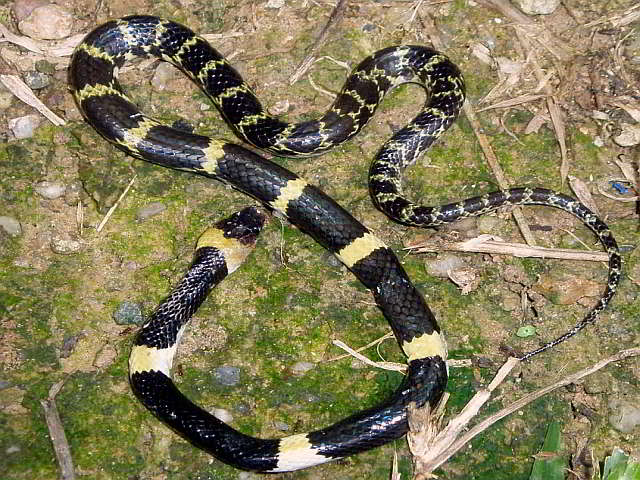
Picture: J. Bulian
 Lycodon laoensis (Laotian Wolf Snake)
Lycodon laoensis (Laotian Wolf Snake)Thai:
 (ngu plong chanuan lao, ngu kan plong)
(ngu plong chanuan lao, ngu kan plong)Size: to 50 cm, very thin
Distribution: In completely Thailand, usually in the hill and mountain country, also in the proximity of settlements.
Behaviour: Evening and night-active animals, which mostly are at the soil. Not very aggressively. Bites nevertheless with annoyance.
Danger level: Innocuous little aggressive snake.
Note: Danger of mistake with:
● Bungarus fasciatus (Krait) venomous
● Boiga dendrophila
● Dryocalamus
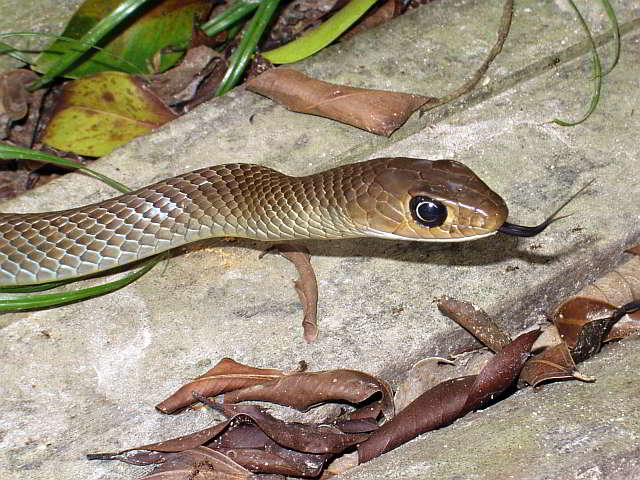
Picture: J. Bulian
 Ptyas korros (Indochinese Rat Snake)
Ptyas korros (Indochinese Rat Snake)Thai:
 (ngu sing ban)
(ngu sing ban)Length: A little over 100 cm
Distribution: Throughout Thailand, but predominantly in the lowland areas.
Behaviour: A snake which is active during the day, is very fast and which usually flees from humans before they get too close. If cornered, the snake bites very quickly and can even jump at their aggressor. This snakes helps keep rats and mice at bay.
Danger level: None
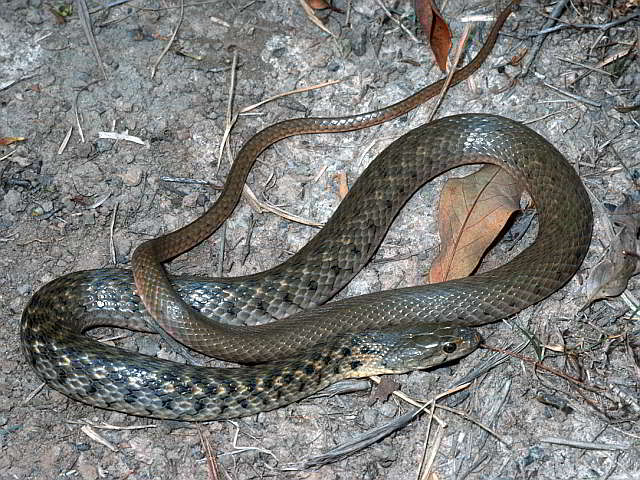
Picture: Wolfgang Grossmann
 Xenochrophis piscator (Checkered Keelback)
Xenochrophis piscator (Checkered Keelback)Thai:
 (ngu lai so yai, ngu daeng hae)
(ngu lai so yai, ngu daeng hae)Length: Up to 120 cm
Distribution: Throughout Thailand in heights up to 1600 meters; more commonly found in flat land up to a height of 300 meters.
Habitat and behaviour: The fish snake can mainly be found near waters. The snake is usually active during the day and often covers large distances on the hunt for food. Many can be found on the streets after a heavy rainfall. If agitated the snakes flatten out their neck region and erect their upper bodies. Due to this defensive reaction they are often mistaken for a cobra. When fleeing the snake moves along smooth surfaces (e.g. streets) in sideways movements and jumps forwards.
Danger level: The snake is not dangerous to humans. If they are threatened or even simply taken in the hand, they do bite very quickly. Whitaker & Captain claimed that they swam in ponds inhabited by fish snakes and were never bitten.
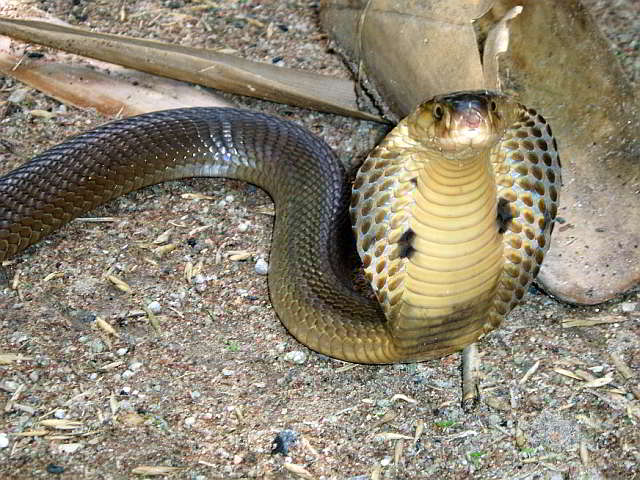
Picture: J. Bulian
 Naja kaouthia (Monocled Cobra)
Naja kaouthia (Monocled Cobra)Thai:
 (ngu hau mo, ngu hau hom)
(ngu hau mo, ngu hau hom)Length: Up to 150 cm
Distribution: The monocled cobra is found relatively frequently throughout Thailand. Naja kauthia , which is also found in India, Nepal, south China and Indochina.
Habitat/behaviour: Naja kaouthia is a ground dwelling snake in the flat country, which can however climb and swim very well. The monocled cobra is equally at home in a wide variety of places: forest and shrub areas, as well as plantations, rice fields, pastures, villages and cities. The monocled cobra is active at night and day, but more often at night. These snakes eat rodents, frogs, toads, ducks and chicks. When threatened they straighten up, spread the neck flat, and hiss. If you react calmly, they usually take flight. The monocled cobra mates in Thailand in the months of December and January. After about two months of mating, the females lay between 10 and 30 eggs. The eggs are laid in moderately damp soil, under heaps of leaves or stones, in the spaces of hollow trees, in rat holes, and in spaces under houses. Depending on the temperature, the eggs incubate from between 50 and 60 days. The young animals are long, between 25 and 30 centimetres, and identical in colouring and appearance to the adults. From my own observations in southern Thailand, I concluded that the females remained at least some days on the clutch of eggs and stayed in the proximity of the clutch of eggs later.
Note: These snakes can vary in colour from light beige to dark brown and grey.
Danger level: This snake has a very powerful life threatening venomous. Strong venomous, deadly!

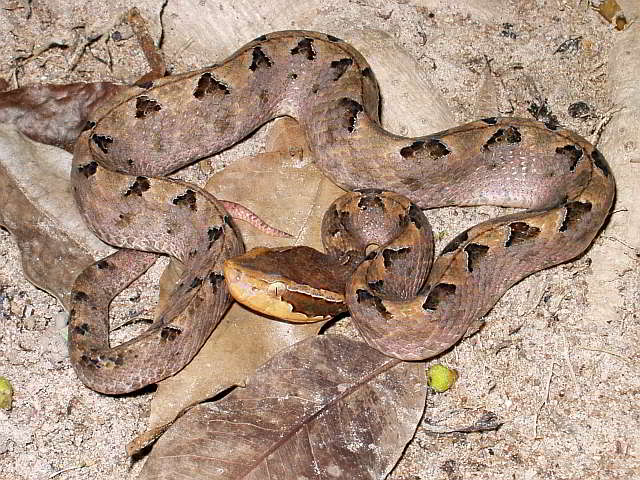
Picture: J. Bulian
 Calloselasma rhodostoma (Malayan Pit Viper)
Calloselasma rhodostoma (Malayan Pit Viper)Thai:
 (ngu gap pha)
(ngu gap pha)Length: Up to 100 cm
Distribution: Resident in the whole of Thailand and is often found under dry leaves, stones or old wood.
Behaviour: Predominantly nocturnal especially when it is drizzling, but also active during the day. It bites, is an aggressive snake and advances very quickly.
Danger level: Strong venomous, deadly!

![[Trimeresurus] Cryptelytrops albolabris (White-lipped Pit Viper) [Trimeresurus] Cryptelytrops albolabris (White-lipped Pit Viper)](../assets/snake_cryptelytrops_albolabris.jpg)
Picture: J. Bulian
 [Trimeresurus] Cryptelytrops albolabris (White-lipped Pit Viper)
[Trimeresurus] Cryptelytrops albolabris (White-lipped Pit Viper)Thai:
 (ngu khiau hang mei tong loeng)
(ngu khiau hang mei tong loeng)Length: 75 cm - male, 104 cm - female
Distribution: Throughout Thailand
Behaviour/habitat: The White-lipped Pit Viper is a very adaptable snake which can be found in wooden and bushy open areas up to 500 meters. It is often found near human settlements. It prefers to stay near to the water. The snake is nocturnal and in search for food (rodents, frogs, lizards, birds) they also move on the ground at night. The Pit Viper strikes quickly and accidents with humans happen frequently. White-lipped Pit Vipers mate in Thailand in September and October. The females give birth up to 16 offspring, which are born in a membrane which the babies break open just after birth. The juveniles have the same coloration as the adults
Note: A normal person cannot tell the difference between the green Pit Vipers. The following Pit Vipers, present in Thailand, have a green colour:
● Cryptelytrops (Trimeresurus) albolabris (White-lipped Pit Viper)
● Viridovipera (Trimeresurus) gumprechti (Gumprecht's Pit Viper)
● Parias (Trimeresurus) hageni Hagen's Pit Viper
● Cryptelytrops (Trimeresurus) macrops (Large-eyed Pit Viper)
● Popeia (Trimeresurus) popeiorum popeiorum (Popes Pit Viper)
● Popeia (Trimeresurus) fucatus *in the works from MALHOTRA & THORPE (2004) not yet entered
● MALHOTRA & THORPE follows, entered here under the name Popeia
● Parias (Trimeresurus) sumatranus (Sumatra Pit Viper)
● Viridovipera (Trimeresurus) vogeli (Bird Pit Viper)
● Cryptelytrops cardamomensis (Cardamom Mountains Green Pitviper)
Danger level: There is a serum against all green Pit Vipers available in Thailand. Bites are very painful but do not usually end fatally. A bad bite can lead to necrosis.
Categories
Venomous animals in Thailand
Spiders
Scorpions
Centipedes
Sea creatures
Mildly venomous and non-venomous snakes
Venomous snakes
DIY Snake catcher
Snake tongs
Prevention snake bites
First Aid after a snake bite
Emergency telephone numbers
≡ Menu
All data is provided without guarantee!